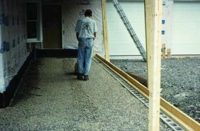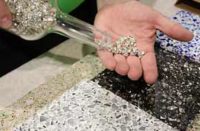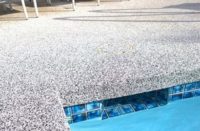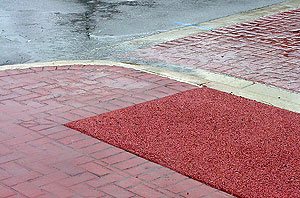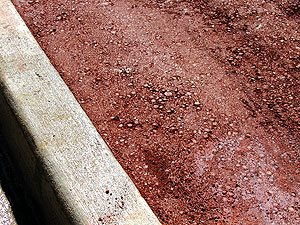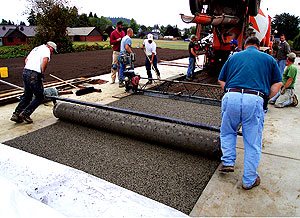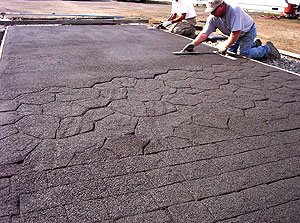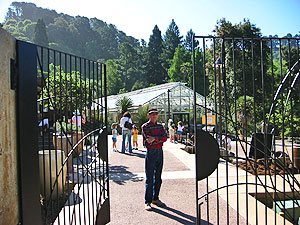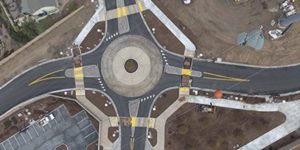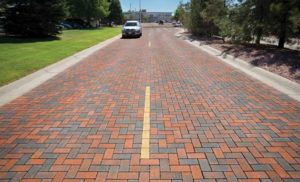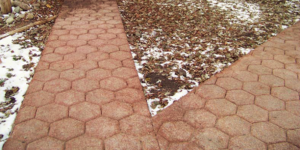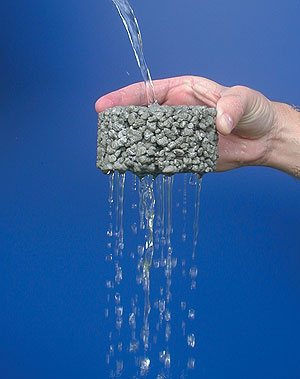 With the addition of color and increased attention to texture and detail, pervious concrete is now being specified for public parks, fine residences, and other hardscapes where appearance is as important to the environment as drainage.
With the addition of color and increased attention to texture and detail, pervious concrete is now being specified for public parks, fine residences, and other hardscapes where appearance is as important to the environment as drainage.
When it rains, it drains. That is the primary reason why pervious pavement is rapidly gaining in popularity. A second reason, however, is that many concrete contractors have learned to produce attractive and more decorative pervious pavement. With the addition of color and increased attention to texture and detail, pervious concrete is now being specified for public parks, fine residences, and other hardscapes where appearance is as important to the environment as drainage.
Environmental alternative
Water cannot penetrate traditional pavement, so rainwater has to be directed away from paved areas. This increases the cost of a project by requiring larger capacity storm drains and retention basins. Ordinary pavements also increase the potential for flooding due to rapid run-off of storm water from paved areas throughout an urban or suburban watershed. And as water sheets across the surface of ordinary pavement, the “first flush” washes contaminants from the pavement into the storm system and contributes to downstream pollution.
To avoid these problems, environmentally conscientious designers and builders are increasingly using pervious portland cement pavement, also referred to as porous pavement. Pervious pavement allows surface water to drain through an open-pored concrete and into the soil below. This not only avoids problems with run-off, but also allows rainwater to percolate into the soil, where it can recharge groundwater and benefit nearby landscaping. Most pollutants entering the pavement are removed by filtration in the pavement’s base course or digestion by microorganisms in the soil. Moreover, the pervious concrete allows air to infiltrate the soil, making it practical to pave under the drip line of trees without suffocating them. For these reasons, pervious pavement has been recognized as a Best Management Practice for storm water management by the U.S. Environmental Protection Agency. Pervious pavement can also help meet the storm water management criteria of the US Green Building Council’s Leadership in Energy and Environmental Design, LEED Credits SS-6.1 and SS-6.2.
What is pervious pavement?
Pervious portland cement concrete is typically made with narrowly graded coarse aggregate, little or no fine aggregate, and a very low water/cementitious materials (w/cm) ratio. The result is a stiff, pebbly mixture with 15 to 25 percent of its volume being interconnecting pores through which water can flow. As an emerging alternative, several recently introduced systems use fine aggregates with proprietary admixtures to assure porosity.
Installing pervious pavement differs in a number of respects from conventional concrete pavement. The concrete is typically placed on a base course of clean, gap graded gravel or crushed rock that acts as a reservoir to hold water until it can infiltrate into the soil. The concrete is placed in conventional forms except that a screed strip 1⁄2 inch to 3⁄4 inch high is placed on top of the forms. After the concrete is placed, the screed strips are removed and a vibratory screed is used to compact the concrete to the required density and thickness, usually about 6 inches. The material is not floated or troweled. Instead, a heavy pipe roller is used to compact the concrete further.
Before venturing into their first large project, contractors should take time to consult with their ready-mix concrete producers and to seek competent technical assistance. The National Ready Mixed Concrete Association (NRMCA) and many regional concrete trade promotion groups have qualified field representatives who can help. NRMCA has also introduced a program to certify pervious concrete craftsmen, and the American Concrete Institute (ACI) is writing standards that will provide guidelines. Resources listed at the end of this article provide guidelines for the subgrade, base course, and pavement engineering, concrete mixture design, and typical installation techniques.
Aesthetic considerations
The listed publications, however, do not have much to say on the aesthetics of pervious pavement. After more than a decade of experience with pervious concrete in the United States, builders now have enough confidence in the product that they are starting to pay attention to its aesthetics as well as its function.
Color, for example, has become an important pervious pavement design element. In visually sensitive areas, natural earth tones can be used to help pavement blend in with the surrounding landscape — whether it is a parking lot in a public park, a path through a garden, service lanes cutting across a lawn, or a driveway in your own front yard. Alternately, the use of a complementary or contrasting color can help a pavement stand out — this can help visitors locate an entrance, improve the visibility of roadway shoulders and traffic islands, or create separate vehicular, pedestrian, and bicycle lanes.
Integral color: Colorants used in pervious concrete should comply with ASTM C979 — Pigments for Integrally Colored Concrete. Iron oxide pigments are most frequently used for the wide spectrum of earth tones; other mineral oxides are used to create shades of green, yellow and blue. Unless it is desired to have a black or dark gray concrete that fades over time, standard carbon black pigments are not suitable for use in pervious concrete because of their potential to leach out of concrete exposed to wet and dry cycles.
The dry mixtures used for pervious concrete require special attention to assure that colorants disperse uniformly throughout a batch; concrete producers should contact their pigment supplier for assistance in determining optimum procedures for adding colorants. While satisfactory results can be achieved with concentrated powder pigments, liquid colors may be more reliable because they are already in solution and can disperse readily in dry mixtures. The water contained in liquid colors and any water added by an automatic dosing system must be subtracted from the amount of batch water added to the concrete.
Another benefit of liquid colors is that they are compatible with automated coloring systems. The automated systems create increased design flexibility by allowing ready mix producers to create an almost unlimited number of custom concrete colors. The automated systems simplify quality control by precisely metering even very small dosages of pigments and creating a record of how much color goes into each batch.
Pervious concrete tends to be darker than other types of concrete because of the low w/cm in the mixture. This means that colored concrete will have a darker or more intense shade than it would in an ordinary concrete mixture with a similar pigment dosage. Other factors that affect the concrete color include the color of the cement, any supplementary cementitious materials such as fly ash, and the aggregate. For a detailed discussion of factors influencing concrete color, a copy of “Ensuring the Quality of Colored Concrete Finishes” is available from the authors.
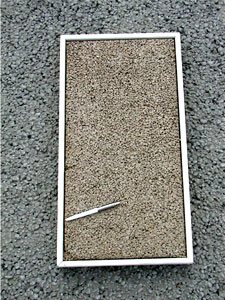 Texture and pattern: Pervious concrete has a rough, open texture that has been compared to a rice cake. Color may be more pronounced because the rough texture reduces the glare associated with conventional concrete pavement. The size and shape (round or angular) of the coarse aggregate in a mixture are significant visual design variables.
Texture and pattern: Pervious concrete has a rough, open texture that has been compared to a rice cake. Color may be more pronounced because the rough texture reduces the glare associated with conventional concrete pavement. The size and shape (round or angular) of the coarse aggregate in a mixture are significant visual design variables.
At present, it is not practical to pattern-stamp typical pervious concrete. The rough texture and absence of fines prevents the material from taking on the texture of conventional stamping tools. While the old-style aluminum “cookie cutter” stamping tools might create an impression, the stiff, highly compacted concrete’s short working time makes them impractical as well, and the edges of stamped patterns would be prone to ravel (crumble). This situation may change, however, since the recently introduced pervious concrete made with fine aggregates and proprietary admixtures appear to be easier to emboss.
Pores in pervious concrete can become filled with silt and other particulate matter. This can affect appearance, particularly if the fill is deeper in some portions of the slab than in others. Periodic vacuuming or power washing will restore the appearance of the pavement as well as assure its continued ability to drain.
As with any concrete, surface wear can erode the cement paste from the surface of a pavement. When this happens, exposed aggregate can have an effect on the pavement’s appearance. So far, experience has shown that the erosion due to traffic is not significantly greater in pervious concrete than it is in conventional concrete so long as it is not used in areas of high-speed traffic. On the other hand, erosion due to water is reduced because liquids enter the pavement instead of draining across the surface.
Joints and score lines: The low w/cm used for pervious concrete reduces the potential for shrinkage cracking. This allows joints to be spaced at greater distances than in conventional paving or to be eliminated altogether. This changes the visual scale associated with concrete panels. Joints are best formed in the compacted concrete with a flanged roller. Joints cut in cured pervious concrete are prone to raveling. If pervious pavement adjoins conventional pavement, joints in the two materials should be aligned to reduce the potential for reflective cracking from one panel to the other.
Curing: Because of its low w/cm and large exposed surface area, pervious concrete requires aggressive curing techniques. NRMCA recommends that pervious concrete be misted and then covered with plastic sheets within 20 minutes of placement. This small window of opportunity limits the amount of finishing work that can be done, although it is possible that some types of stamping can be done after the plastic is placed. Edges of the plastic should be held in place with dirt or lumber to contain moisture. The plastic should remain in place for not less than seven days.
Contact between the concrete and plastic can cause uneven coloration of the concrete. If this discoloration is not acceptable in a pervious project, consider a method of tenting the pavement so the plastic does not come in direct contact with the concrete.
Coloring with stains
Cured pervious concrete can be stained. Bear in mind, however, that it will be difficult to apply stain to all exposed surfaces within the pores of the concrete. In addition, liquid-based stains may drain away from the surface before they have had sufficient contact time to impart coloring. Stains only color the surface of the concrete, so any raveling would expose unstained concrete. With this in mind, stains are best used in conjunction with integrally colored concrete; the stains can create accent panels or borders, for example, while the integral color provides shading throughout the depth of the concrete.
Stains produce an inherently mottled appearance, even on regular concrete. This effect may be even more pronounced when applied to the already variegated surface of pervious concrete. Since there is limited experience in the industry staining pervious pavement, trial applications and mock-ups are highly recommended before proceeding with a project.
Other design options
Pervious pavement can be combined with conventional concrete pavement to create visual interest. For example, broomed colored concrete borders can be used around panels of pervious paving in a complementary color.
Spray-applied sealers can be used to create a gloss surface. Care must be used to assure that the sealer does not clog pores.
Slightly grinding the surface of cured pervious pavements removes prominences to reduce the roughness of the concrete for improved walking comfort and less road noise. The depth of the grinding and the color of the aggregate have an effect on the pavement’s appearance.
Select aggregates can be broadcast onto the surface of the pavement after screeding and then tamped into the surface during compaction to create exposed aggregate finishes.
Where the concrete is not intended for pedestrian use — as erosion protection on the embankment of a stream, for example — the compacted surface can be raked or otherwise roughened to create a deliberately rustic surface.
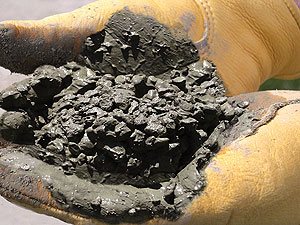 Look, then leap
Look, then leap
Maintaining consistency of pervious concrete from batch-to-batch (and even from the beginning of a batch placement to its end) can be challenging whether it is colored or uncolored. While a cardinal rule of conventional colored concrete is to avoid adding water to a mixture at the job site, it may be necessary to violate this precept in order to maintain the correct consistency of pervious concrete. With a dry mixture and large surface area, pervious concrete is prone to inconsistent evaporation due to workmanship, sunlight and wind. When either of these scenarios occurs, even small changes in w/cm will alter pavement appearance. Add to this the discoloration that can occur due to contact between concrete and plastic sheets during curing, plus the raveling that occurs on even the best pervious concrete projects, and it should come as no surprise that pervious pavement does not always look “pretty.”
Still, it can be beautiful when accepted on its own terms and integrated into an overall project design. At the recently remodeled entry to the University of California’s botanical garden, for example, the designer wanted a natural-looking pervious material for walkways, and proposed crushed rock. When the University’s facility department expressed concern about crushed rock damaging floors if it was tracked into adjacent buildings, the landscape architect turned to the similarly rustic appeal of colored pervious concrete. At another recent project, colored pervious pavement was used for the parking lot near a beach. The owner readily accepted the variations in pavement appearance by saying they were reminiscent of the beach itself.
Customer expectations, however, must be managed. Customers should be shown other projects with representative workmanship and realistic tolerances must be established. Final color selection should be made, whenever possible, from samples made with the actual materials proposed for a project. Mock-ups or field samples should be constructed before proceeding with large or complex projects so a clear standard of performance can be established.
Until recently, pervious pavement has been used primarily in parking lots. With growing demand for pervious pavement in residential and smaller-scale projects, decorative concrete contractors will find that their attention to detail and willingness to learn new techniques makes them well prepared to take advantage of the new opportunities. Pervious concrete is still a young art form, and new products and techniques are likely to expand its palette of decorative options. In this creative environment, providing consumers with their choice of colors will help them embrace pervious pavement as an attractive way to protect the natural environment.
Additional Contributing Author
Nick Paris is vice president for marketing at Davis Colors, a leading producer of concrete colorants, and the author of numerous papers on concrete coloring. He can be reached at www.daviscolors.com.
